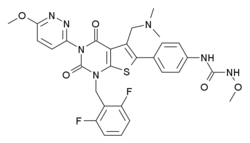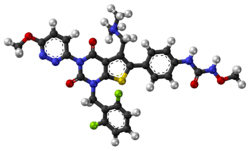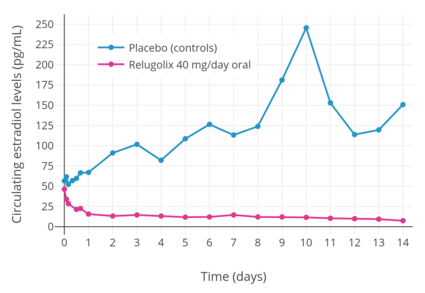Relugolix
Relugolix, sold under the brand name Relumina, is a gonadotropin-releasing hormone antagonist (GnRH antagonist) medication which is used in the treatment of uterine fibroids in Japan.[2][3][1] It is also under development for use in other countries and for the additional indications of endometriosis and prostate cancer.[2][4][5][6][7][8][9] It is taken by mouth once per day.[1][3]
 | |
 | |
| Clinical data | |
|---|---|
| Trade names | Relumina |
| Other names | RVT-601; TAK-385 |
| Routes of administration | By mouth[1] |
| Drug class | GnRH antagonist |
| Pharmacokinetic data | |
| Protein binding | 68–71%[1] |
| Elimination half-life | 36 to 65 hours[1] |
| Excretion | Feces: 82%[1] Urine: 4%[1] |
| Identifiers | |
IUPAC name
| |
| CAS Number | |
| PubChem CID | |
| PubChem SID | |
| DrugBank | |
| ChemSpider | |
| UNII | |
| KEGG | |
| ChEMBL | |
| CompTox Dashboard (EPA) | |
| Chemical and physical data | |
| Formula | C29H27F2N7O5S |
| Molar mass | 623.630 g·mol−1 |
| 3D model (JSmol) | |
SMILES
| |
InChI
| |
Side effects of relugolix include menstrual abnormalities, hot flashes, excessive sweating, headache, and decreased bone mineral density.[3][1] Relugolix is a GnRH antagonist, or an antagonist of the gonadotropin-releasing hormone receptor.[1] Unlike most other GnRH modulators, but similarly to elagolix (brand name Orilissa), relugolix is a non-peptide, small-molecule compound and is orally active.[8][9][10] It suppresses sex hormone levels to the postmenopausal or castrate range in both women and men with administration once per day.[1][11]
As of February 2019, relugolix is in phase III clinical trials for endometriosis and prostate cancer.[2] It was approved for use for the treatment of uterine fibroids in Japan in January 2019.[2][12] A New Drug Application of relugolix for uterine fibroids is expected to be submitted in the United States late 2019.[2]
Medical uses
Relugolix is approved in Japan for the treatment of uterine fibroids (uterine leiomyoma) in women.[2][3] It is used at a dosage of 40 mg once daily by mouth for this indication.[1]
Side effects
The main side effects of relugolix include abnormal uterine bleeding (24.6–48.6% vs. 6.3% for placebo), hot flashes (42.8–45.5% vs. 0% for placebo), heavy menstrual bleeding (12.1–49.3% vs. 9.4% for placebo), headache (12.3–15.2%), and excessive sweating (9.4–15.2% vs. 0% for placebo).[1][3] In addition, decreased bone mineral density occurs with relugolix (21.7% decrease by week 12, 24.4% decrease by week 24).[1]
Pharmacology
Pharmacodynamics

Relugolix is a selective antagonist of the gonadotropin-releasing hormone receptor (GnRHR), with a half-maximal inhibitory concentration (IC50) of 0.12 nM.[1][8][9]
A dosage of relugolix of 40 mg once per day has been found to suppress estradiol levels to postmenopausal levels (<20 pg/mL) within 24 hours in premenopausal women.[1] In the control group of women, estradiol levels fluctuated between 50 and 250 pg/mL.[1] Estradiol levels have been found to return to normal concentrations within 4 weeks of discontinuation of relugolix in premenopausal women.[1] The medication additionally suppresses levels of progesterone, luteinizing hormone, and follicle-stimulating hormone in premenopausal women.[1] Relugolix at a dosage of 40 mg or more once per day has been found to reduce testosterone levels to sustained castrate levels (<20 ng/dL) in men.[11] It additionally suppresses luteinizing hormone and follicle-stimulating hormone levels in men.[11]
Lower doses of relugolix (<40 mg/day) are under investigation for achieving partial sex hormone suppression in the treatment of endometriosis and uterine fibroids.[6] This is intended to reduce the incidence and severity of menopausal symptoms such as hot flushes and decreased bone mineral density that are secondary to estrogen deficiency.[6][13]
Pharmacokinetics
A single 40-mg oral dose of relugolix has been found to result in peak levels of relugolix of 29 ng/mL (47 nmol/L) after 1.5 hours.[1] Steady-state levels are reached within 7 days with 40 mg/day relugolix administration.[1] There is an approximate 2-fold accumulation of relugolix by 2 weeks of continuous administration.[1] Food diminishes the oral bioavailability of relugolix by about 50%.[1]
Relugolix is a substrate for P-glycoprotein, which may have a limiting effect on its absorption and distribution.[1] The plasma protein binding of relugolix is approximately 68 to 71% over a concentration range of 0.05 to 5 μg/mL.[1]
Relugolix is not a substrate for CYP3A4.[1] The elimination half-life of relugolix is 36 to 65 hours across a dosage range of 20 to 180 mg/day.[1] There is moderate to high interindividual variability in systemic exposure to relugolix.[1]
Relugolix is excreted mainly in feces (83%) and to a small degree in urine (4%).[1] Only about 6% of a dose of relugolix is excreted unchanged.[1]
Chemistry
Relugolix is a non-peptide, small-molecule compound, and is structurally distinct from GnRH analogues.[10] It is an N-phenylurea derivative.[1]
History
Relugolix was first described in 2004.[14][8] It superseded sufugolix (developmental code name TAK-013), which was developed by the same researchers.[8] Relugolix was approved for the treatment of uterine fibroids in Japan on 8 January 2019.[2][12] It was the second orally active GnRH antagonist to be introduced for medical use, following elagolix (brand name Orilissa) in July 2018.[2][15]
Society and culture
Research
Relugolix is under development by Myovant Sciences and Takeda for the treatment of uterine fibroids in countries besides Japan such as the United States.[2] Myovant Sciences intends to submit a New Drug Application of relugolix for uterine fibroids in the United States in the fourth quarter of 2019.[2] Relugolix is also under development for the treatment of endometriosis and prostate cancer in the United States, Japan, and other countries.[2] As of February 2019, it is in phase III clinical trials for these indications.[2]
See also
- Gonadotropin-releasing hormone receptor § Antagonists
- List of investigational hormonal agents § GnRH/gonadotropins
References
- Barra F, Seca M, Della Corte L, Giampaolino P, Ferrero S (August 2019). "Relugolix for the treatment of uterine fibroids". Drugs Today. 55 (8): 503–512. doi:10.1358/dot.2019.55.8.3020179. PMID 31461087.
- http://adisinsight.springer.com/drugs/800028257
- "Relumina (relugolix) Information - ASKA Pharmaceutical" (PDF) (in Japanese). ASKA Pharmaceutical. January 2019. Retrieved 16 February 2019.
- Goenka L, George M, Sen M (June 2017). "A peek into the drug development scenario of endometriosis - A systematic review". Biomed. Pharmacother. 90: 575–585. doi:10.1016/j.biopha.2017.03.092. PMID 28407578.
- Dellis A, Papatsoris A (October 2017). "Therapeutic outcomes of the LHRH antagonists". Expert Rev Pharmacoecon Outcomes Res. 17 (5): 481–488. doi:10.1080/14737167.2017.1375855. PMID 28870102.
- Streuli I, de Ziegler D, Borghese B, Santulli P, Batteux F, Chapron C (March 2012). "New treatment strategies and emerging drugs in endometriosis". Expert Opin Emerg Drugs. doi:10.1517/14728214.2012.668885. PMID 22439891.
- Elancheran, R.; Maruthanila, V. L.; Ramanathan, M.; Kabilan, S.; Devi, R.; Kunnumakara, A.; Kotoky, Jibon (2015). "Recent discoveries and developments of androgen receptor based therapy for prostate cancer". Med. Chem. Commun. 6 (5): 746–768. doi:10.1039/C4MD00416G. ISSN 2040-2503.
- Miwa K, Hitaka T, Imada T, Sasaki S, Yoshimatsu M, Kusaka M, Tanaka A, Nakata D, Furuya S, Endo S, Hamamura K, Kitazaki T (July 2011). "Discovery of 1-{4-[1-(2,6-difluorobenzyl)-5-[(dimethylamino)methyl]-3-(6-methoxypyridazin-3-yl)-2,4-dioxo-1,2,3,4-tetrahydrothieno[2,3-d]pyrimidin-6-yl]phenyl}-3-methoxyurea (TAK-385) as a potent, orally active, non-peptide antagonist of the human gonadotropin-releasing hormone receptor". J. Med. Chem. 54 (14): 4998–5012. doi:10.1021/jm200216q. PMID 21657270.
- Nakata D, Masaki T, Tanaka A, Yoshimatsu M, Akinaga Y, Asada M, Sasada R, Takeyama M, Miwa K, Watanabe T, Kusaka M (January 2014). "Suppression of the hypothalamic-pituitary-gonadal axis by TAK-385 (relugolix), a novel, investigational, orally active, small molecule gonadotropin-releasing hormone (GnRH) antagonist: studies in human GnRH receptor knock-in mice". Eur. J. Pharmacol. 723: 167–74. doi:10.1016/j.ejphar.2013.12.001. PMID 24333551.
- Tukun FL, Olberg DE, Riss PJ, Haraldsen I, Kaass A, Klaveness J (December 2017). "Recent Development of Non-Peptide GnRH Antagonists". Molecules. 22 (12). doi:10.3390/molecules22122188. PMC 6149776. PMID 29232843.
- MacLean DB, Shi H, Faessel HM, Saad F (December 2015). "Medical Castration Using the Investigational Oral GnRH Antagonist TAK-385 (Relugolix): Phase 1 Study in Healthy Males". J. Clin. Endocrinol. Metab. 100 (12): 4579–87. doi:10.1210/jc.2015-2770. PMC 4667159. PMID 26502357.
- https://www.prnewswire.com/news-releases/myovant-provides-corporate-updates-and-reports-financial-results-for-third-fiscal-quarter-ended-december-31-2018-300791994.html
- Struthers RS, Nicholls AJ, Grundy J, Chen T, Jimenez R, Yen SS, Bozigian HP (February 2009). "Suppression of gonadotropins and estradiol in premenopausal women by oral administration of the nonpeptide gonadotropin-releasing hormone antagonist elagolix". J. Clin. Endocrinol. Metab. 94 (2): 545–51. doi:10.1210/jc.2008-1695. PMC 2646513. PMID 19033369.
- https://patents.google.com/patent/US7300935/
- https://adisinsight.springer.com/drugs/800020238
- https://chem.nlm.nih.gov/chemidplus/rn/737789-87-6
- https://www.kegg.jp/entry/D10888
Further reading
- "Relumina (relugolix) Information - ASKA Pharmaceutical" (PDF) (in Japanese). ASKA Pharmaceutical. January 2019. Retrieved 16 February 2019.
- Markham, Anthony (April 2019). "Relugolix: First Global Approval". Drugs. 79 (6): 675–679. doi:10.1007/s40265-019-01105-0. ISSN 0012-6667.
- Elsharoud, A.; Ali, M.; Al-Hendy, A. (2019). "Relugolix. GnRH (LHRH) receptor antagonist, Treatment of uterine fibroids, Treatment of endometriosis-related pain, Treatment of prostate cancer". Drugs of the Future. 44 (2): 131. doi:10.1358/dof.2019.44.2.2927590. ISSN 0377-8282.
- Barra F, Seca M, Della Corte L, Giampaolino P, Ferrero S (August 2019). "Relugolix for the treatment of uterine fibroids". Drugs Today. 55 (8): 503–512. doi:10.1358/dot.2019.55.8.3020179. PMID 31461087.
External links
- Relugolix - AdisInsight
- Relugolix - Myovant Sciences
- Relumina (relugolix) Information - ASKA Pharmaceutical